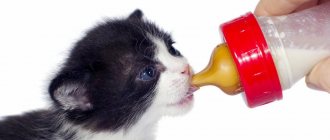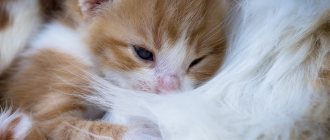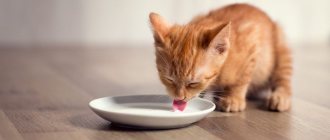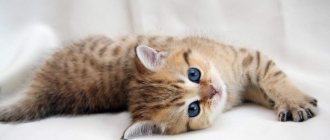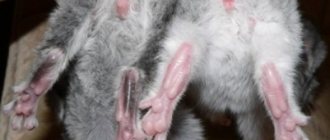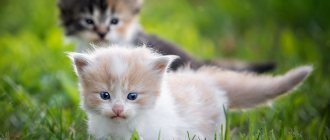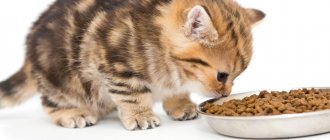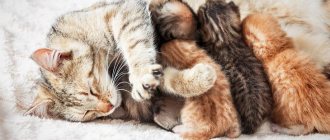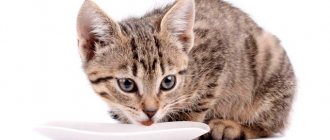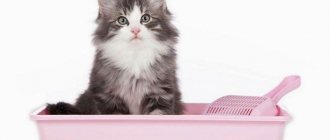Save the article:
feed a newborn kitten for various reasons. In any case, this is a serious responsibility for a small life.
The neonatal period for kittens ends at the age of two weeks. But these first two weeks of life play a decisive role not only in the future health of babies, but also for their very existence. During these two weeks, the kitten adapts to living outside the mother’s body, organs and systems continue to develop, breathing and circulatory processes normalize, the endocrine glands begin to work, changes in metabolism occur, and normal thermoregulation is established. And if during this period the owner is inattentive to the feeding procedure, then in addition to the development of diseases, this can lead to the death of the baby.
How often to feed a newborn kitten
The frequency of feeding kittens abandoned by a cat has long been determined by experts.
Until the fourth day of life, babies are fed every 2 hours around the clock. On the fifth day, the frequency changes: the baby can tolerate it for 3 hours. From the 14th day, only one night feeding is left, daytime feedings are left at the same interval. After 25 days of life, you need to feed 1 time at night; during the day, the interval between meals is 3-4 hours. From the 35th day, a gap of 4 hours is left during the day, and night feeding is removed.
If you have the fate of feeding a newborn kitten in the first days, then do not overfeed the cub: he is given 3-4 ml per feeding. With growth, the interval between meals and the single dose increase.
Cooking Features
It is necessary to pay attention to the temperature of the food. Since cold food disrupts digestion, hot food burns the oral cavity. From the first days of feeding, the temperature should be 37 degrees - an approximate indicator for the kitten’s body.
Lower this level every week. By the end of the month, the mixture should be at room temperature - 24 degrees. If there is nothing to measure, proceed as follows. The bottle is pressed against the bend of the elbow, nothing is felt - neither cold nor heat - you can give it to the kitten.
Calculation of the amount of mixture
You need to get a measuring spoon to properly prepare food for newborns. The amount of feed is calculated taking into account body weight.
- Days 1–4 – 30 ml of the prepared mixture per 100 g of weight;
- 5 –13 – 38 ml;
- 14 –24 – 46 ml;
- 25 –35 – 53 ml per 130 g body weight.
Feeding Basics for Newborn Kittens
global $ads_google;
//data-ad-slot=”2475549904″ $ads_google = empty($ads_google) ? false : true; ?> if ($ads_google == false) {?> $ads_google = true; ?> } ?> If a cat does not feed newborn kittens , then the owner will have to become the mother.
To prevent the process from causing inconvenience, sit down comfortably and place a diaper on your knees. The cub is placed on the prepared bedding - it should lie as if it were being fed by a mother cat. If it is a newborn, then he is placed lying down and his head is raised slightly. It is important to ensure that your head is not thrown back excessively!
After placing the baby, they begin the feeding process itself.
Feeding methods
If you had to replace the furry mother, you need to know how to feed newborn kittens without a cat. First use a pipette or syringe. Although you can find specialized nipples and bottles in pet stores.
A drop of milk is squeezed out of the pipette and the crumbs are brought to the spout. As soon as the baby smells the milky aroma, he begins to look for the nipple. It is at this time that the new “mother” puts a syringe or pipette with milk mixture into his mouth. The main thing is not to swallow a lot of air, which can lead to abdominal pain.
Feeding diet for a newborn kitten
If feeding the kitten falls entirely on the shoulders of a person, then you need to take into account the laboriousness of the process and regularly allocate time for this. If there is no nurse cat nearby who would agree to take other people’s babies under her wing, then you need to think about the most suitable replacement for cat’s mother’s milk.
Together with mother's milk, kittens receive immunity, minerals and vitamins. A suitable mixture can be a replacement. You can buy it at a pet store or prepare it yourself. It is not advisable to heat the mixture in the microwave; it is better to heat it in a water bath until warm. Before giving the cat something to eat, they try to leave a drop of milk on their wrist so that the cub doesn’t get burned. In the first two weeks, the food temperature should correspond to the baby’s body temperature.
At the end of the newborn period, complementary foods consisting of formula and milk porridge begin to be introduced. Starting from day 21, it is useful to diversify the menu with low-fat cottage cheese, baby meat food, egg yolk, fish and lean beef. Starting from day 35, kittens are quite capable of eating from a bowl.
Is it possible to give cats baby food?
- Is it possible to give baby food to a cat? Advantages and disadvantages
- What is baby food
- What can be replaced?
What is baby food?
Many owners believe that everything made for children is absolutely hypoallergenic and safe, so without hesitation they give baby food to cats and kittens. This means special purees and mixtures of vegetables and meat intended for feeding babies. The most popular manufacturers are “Gerber” and others. However, are such dishes included in the list of foods that are not harmful to your pets? Let's find out!
Is it possible to give baby food to a cat? Advantages and disadvantages
The general answer is yes, it is possible, but there are many nuances that the Murkoshi team will tell you about in this article.
First of all, it is worth understanding that cats are predators and that among infant formulas, meat ones are most suitable for them (except in some special cases). An acceptable option for baby food for a cat is in those moments when the cat is weakened and cannot chew and digest heavy, nutritious food. This is usually associated with past illnesses and operations, with diseases of the esophagus and gums.
For example, veterinarians recommend giving baby food to older cats that develop gum disease and experience tooth loss. If your pet has a sensitive esophagus that is not able to digest heavy food or food in pieces for some reason, then this type of food can also be offered to him.
With such a serious health condition, baby food for a cat will be an excellent alternative to regular food, but owners should pay attention to other important aspects. The first of these is what the food consists of.
First, it’s worth understanding what kind of baby food (that is, consisting of which components) should be offered to your cat. To do this, it is advisable to know if the furry one is allergic to any vegetables or meat. The surest way to check is to give your pet one or another puree (beef or chicken, containing certain vegetables) in a small amount and monitor its condition. If you notice fever, diarrhea, vomiting or any other unhealthy reaction in your cat, stop feeding it this product. Offer another mixture, first checking its components for similarity with the previous ones and making sure that they are not repeated. If there is a reaction to this, then it is possible that it is better to avoid infant formula from this particular manufacturer. If you still intend to accustom your cat to baby food, then conduct similar experiments with products from another company.
Read more about allergies: Food allergies in cats
Next, you should check the composition for the presence of components harmful to the cat’s body. Of course, baby food does not contain preservatives, but there are still many other substances harmful to cats. First of all, you should not buy formulas that contain soy for your cat, as this is not part of the cat’s natural diet and can lead to serious digestive problems. Lactose is also categorically not recommended for cats, since many whiskered cats are intolerant to this substance.
Read more about the dangers of lactose: Is it possible to give milk to cats?
Important! Baby food for a cat should under no circumstances contain onions, garlic or salt! Onions and garlic contain a disulfide compound that helps break down red blood cells in your cat's body. Its constant presence in the blood leads to the development of hemolytic anemia and can be fatal. If baby food contains sugar or salt in large quantities, then it should also be avoided, because these substances lead to serious disruptions in the functioning of the digestive system, liver and kidneys.
What other table foods are harmful to cats: https://murkosha.ru/nashi-stati/soderzhanie-i-ukhod/luchshaya-eda-dlya-koshki-so-stola-mify-i-realnost
At the Murkosha shelter we always carefully check the components of the food that is given to our cats, and we take products only from proven and truly high-quality manufacturers. Every owner should be equally careful when choosing their pet’s diet.
Many owners mistakenly believe that they can feed their cats expired baby food. However, this opinion is completely wrong! The cat's body is just as sensitive to spoiled foods as human ones, so overstaying can cause poisoning and intoxication.
Another disadvantage of feeding a cat baby food is that it is still intended for human children. Baby food for kittens is not a product that should replace everything else like professional food. Be that as it may, the best nutrition option for a healthy kitten is mother’s milk, and then special food, because it contains all the necessary vitamins and minerals for the healthy growth of the kitten.
It is also a mistake to feed your cat baby food that consists exclusively of meat. It would be more correct to combine it with vegetable mixtures to maintain the proper level of all the vitamins and nutrients the cat needs - because the mustachioed pet needs not only proteins, but also carbohydrates and fiber. And here lies the main problem: at home it is very difficult, almost impossible, to maintain the necessary balance when feeding a cat natural products or formulas (including baby food) intended for humans. Therefore, baby food is a serious compromise in any case. For comparison, professional super-premium and holistic-class feeds (which are used in Murkosh) have a precisely adjusted balance of nutrients, and also contain a vitamin and mineral complex.
Read about super premium food: Super premium cat food
About holistic food: Holistic food for cats
Thus, baby food for kittens and adult cats should not be the main dish in the diet - but only a product used in case of health problems in the animal, as a way to switch a cat from one food to another, or only as a vitamin supplement.
What can be replaced?
Of course, the most obvious alternative to baby food for kittens is professional food labeled “for kittens.” For the little ones (but who have already stopped feeding on mother cat's milk), we recommend wet food. It usually consists of specially ground pieces of meat, and also includes a wide range of vitamins for healthy growth and development of furry.
Now many companies have begun to produce food in the form of a pate, which is a more than worthy alternative to meat mixtures, and (if it is a high-quality food - super premium and holistic class) it already contains all the useful substances necessary for the growth of a kitten.
Read more about pates: Pates for cats
So, baby food for cats and kittens (necessarily without onions, garlic, soy, lactose, salt, sugar!) is an acceptable, but not the most desirable option. However, owners should always carefully monitor the cat’s condition after eating such products, and also contact a veterinarian if symptoms of an allergic reaction appear. Remember that your pet's health is entirely in your hands!
Preparing a kitten feeding kit
To feed a kitten without a cat, you need to prepare everything you need, so that later it doesn’t turn out that something necessary is missing at that very moment.
First of all, you need to purchase auxiliary devices. You will need:
- plastic pipette;
- disposable syringe with a volume of 20 ml;
- catheter;
- pacifier;
- a small bottle with a narrowed spout (for children or intended for drinking kittens);
- measuring spoon;
- convenient bowl.
It is better to take several different pipettes and nipples at once, as some may not be suitable due to poor quality or may not withstand frequent washing. Syringes should also always be in stock.
If financial resources allow, you can simply purchase a ready-made kit for feeding animals: it includes a plastic bottle with a volume of 35 or 55 ml and a silicone nipple of a suitable size for one-week and two-week-old kittens.
Feeding with ready-made formulas
global $ads_google;
//data-ad-slot=”2475549904″ $ads_google = empty($ads_google) ? false : true; ?> if ($ads_google == false) {?> $ads_google = true; ?> } ?> If you need to feed a kitten from its very birth, then you need to know what such babies are fed. Many people wonder whether it is possible to feed newborn kittens with infant formula or whether they will have to buy only specialized ready-made formulas.
If the situation is extreme, and there is baby formula in the house, then it can be diluted in a 1:2 ratio with water. Baby food formulas for the digestive system of kittens are too fatty and rich in micro- and macroelements. Diluted with water in the right proportion, they become less concentrated and heavy for the kitten’s stomach.
Cat milk substitutes have long been developed and sold in veterinary pharmacies. The milk of other animals is less suitable and can easily upset the animal's stomach.
Feeding formulas can be purchased in both liquid and powder form. The digestion of cat babies functions normally, the intestinal microflora is in perfect order.
Expert opinions
Veterinarians often argue, citing their observations and beliefs as evidence:
- some argue that children and kittens have different digestive systems, so what is designed for the human body should not be used for cats;
- others refer to the considerable experience of cat owners, because they have raised more than one generation of purrs. Their artificially fed kittens are practically no different in appearance from their relatives in development. They play just as happily, eat with appetite and are completely healthy, thanks to this complementary feeding.
What natural foods can you feed kittens?
But there are situations in which you have to take care of a newborn kitten yourself. And this is not an easy task. The most difficult thing is to properly feed a kitten . The slightest inattention to the quality of food and the feeding process can lead to poor health, the development of serious diseases and even the death of the pet.
If we are talking about a kitten up to two weeks old, then from natural products rice water, goat milk and condensed milk without sugar are suitable. The first portion should be very small in order to monitor the body's reaction to the new product.
You can also add corn oil, raw egg, and bone meal to the mixture.
If the baby has grown up and the question arises of how to feed a month-old kitten, then the situation here is simpler: cottage cheese, boiled chicken yolk, porridge with meat or milk broth and boiled vegetables are happily kneaded.
Cooking Recipes
Several proven recipes for kittens during the neonatal period:
Recipe No. 1
For 5 parts of 20% condensed milk take 1 part water, 1 tsp. bone meal and 1 liter of milk. All ingredients are mixed until smooth, the liquid is filtered and cooled to 36-38°C.
Recipe No. 2
For a glass of milk take 2 yolks, 1 tsp. vegetable oil, optionally a drop of vitamins.
Recipe No. 3
Food for weakly healthy kittens.
Half a glass of full-fat milk, yolk, 20 ml of glucose 5%, a drop of vitamins.
Strain the mixture and sell within 24 hours. Store the composition in the refrigerator and warm up to 37 °C before use.
Recipe No. 4
All components are taken per 1 kg of kitten weight, you will have to calculate everything correctly.
You need to take 50 g of full-fat milk, 15 g of whole milk powder, 3 g of dry yeast, 1 egg, 50 g of whipped protein, 1 g of vegetable oil, 4 g of glucose. The composition is mixed and heated to 37-38°C
Recipe No. 5
You will need 25 g of cow's milk, 5 g of whole milk powder, 2 g of glucose, 1 g of vitamin supplements.
Recipe No. 6
You need to take a teaspoon each of bone meal and milk, 5 tsp. 20% condensed milk and mix everything.
Recipe No. 7
To 50 g of whole milk powder add the same amount of boiled milk, half a raw yolk and 1 tsp. corn oil.
Recipe No. 8
Take 100 g of milk, yolk, 0.5 tsp. vegetable oil, 20 ml of 5% glucose, a drop of vitamins.
Tables of norms by age
In order to make it more convenient to understand how many times a day a small kitten should be fed, we have compiled both the amount of food and the number of feedings per day into a single table.
| Kitten age | Amount of food per day in grams (it is divided into equal-sized portions for as many feedings as the pet’s age requires) | Number of feedings per day |
| 4-8 weeks | 120 | 7 |
| 8-112 weeks | 160-180 | 6 |
| 12-20 weeks | 180-240, with a minimum meat volume of 40 g | 5 |
| 5-9 months | 180-200 | 4 |
| 9-12 months | 180-200 | 3 with gradual transition to 2 by age 1 year |
For each kitten, the norms may vary slightly depending on its individual characteristics. However, it is necessary to use them as a guide, since otherwise the pet may not receive enough nutrition or, conversely, be overfed, and obesity in cats poses a great danger, leading to the rapid development of pathologies of internal organs.
What should you not feed newborn kittens?
If you listen to the advice of experts, ignoring common sense, then it won’t take long for things to get into trouble. There are several “don’ts” in feeding newborn kittens, in addition to a strict feeding schedule, dosage and food intake rules.
- Cow's milk is not used in its pure form, as this can lead to severe indigestion and possible death.
- No cream, even diluted with water.
- Don’t rush and shove sausage or minced meat into your baby’s mouth.
- When the baby gets a little older, you also shouldn’t rush to feed him raw freshwater fish, otherwise he may be attacked by helminths.
